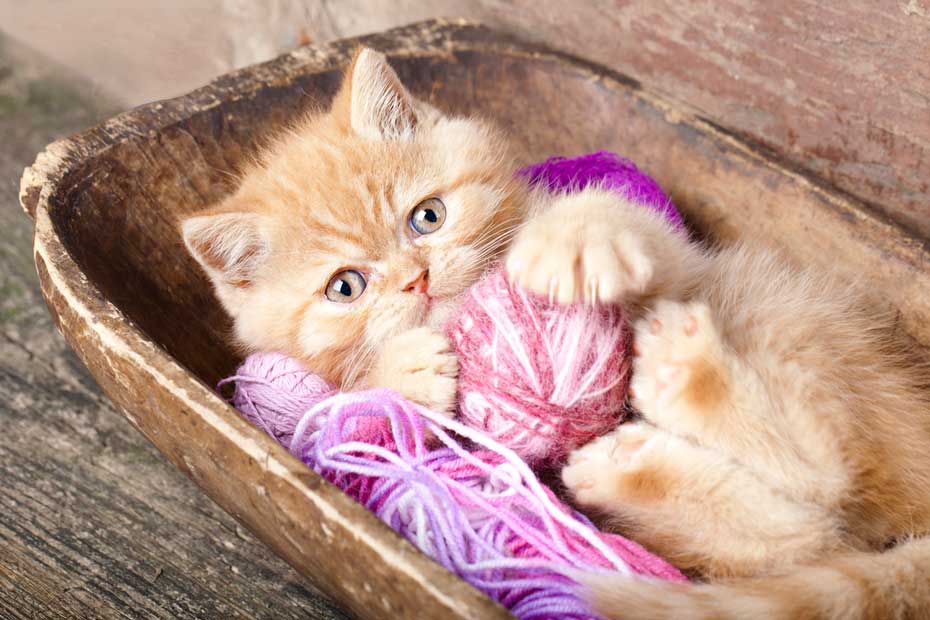The Dangers of Strings, Ribbons, and Yarn for Cats

It's no secret: cats love strings. Yarn, ribbon, tinsel, thread, twine, shoelaces, rubber bands, hair ties, and cords are all prime targets for a cat's stalking, pouncing, and thrashing instincts. Unfortunately, these are all very dangerous items for your cat to play with unsupervised (or even supervised sometimes).
Why Are Strings Dangerous for Cats?
If you've ever had a cat lick you, you're aware of how rough the feline tongue feels. The reason for this is that a cat's tongue is covered with barbs that point toward his throat. These barbs are useful when cats groom themselves, for pulling out dead fur. In the wild, they would also help pull meat from bones to aid the cat in getting all of the food he could from his prey.
The barbs on a cat's tongue, because of the direction they face, do not allow a cat to spit anything out once it is caught on the tongue. Fabrics and strings are easily captured on the barbs, and then the item can only be swallowed unless the cat manages to hook it with his paws and pull it out.
But Why Is It so Bad If a Cat Swallows a String?
When a cat swallows a string or other similar item, the chances are high that he will develop a linear foreign body. This means that one end of the string lodges somewhere along the GI tract while the rest continues on. The most common places for strings to lodge are around the base of the tongue and in the bottom of the stomach, where it empties into the small intestine. This area of the stomach is the pylorus.
The intestinal tract attempts to move the string along as it would any of its other contents. However, since the other end of the string is lodged, the intestine actually plicates, or bunches up on itself. This effect is similar to what would happen if you tied a knot in one end of a drawstring, then pulled on the other end. The fabric would bunch up around the drawstring (Wendy C. Brooks, 2014).
Eventually, the tissue in the area around the plication can lose blood supply and begin to deteriorate and die. In extreme situations, the intestine can tug so hard on the foreign body that it tears through the tissue, allowing GI contents to spill into the abdominal cavity. This results in a serious condition called peritonitis. Peritonitis is the poisoning of the cat's system, and it will result in death if it isn't treated. Linear foreign bodies are a surgical emergency in cats. The foreign body, along with any dead intestinal tissue, must be surgically removed. This type of surgery is particularly dangerous and carries a higher risk of death than other types of foreign body removal surgeries.
Another Problem with Strings
Strings or any string-like object can become wrapped around any part of a cat that is rolling around and playing with it. This includes extremities like the paws and legs and the neck. Paws and legs that are wrapped tightly in strings can lose blood supply, and the need for an amputation is a very real possibility. Cats with strings caught around their necks usually begin to run frantically around the house trying to get away. This can result in the other end of the string becoming caught on another object, resulting in asphyxiation and death. Strings and cats just don't mix.
How to Avoid the Dangerous Consequences of Cats with Strings
Because of the multiple issues of a cat's barbed tongue, a linear foreign body causing plication of the intestinal tract, and entanglement dangers, strings, yarn, ribbon, and other linear objects are extremely dangerous for cats. Following are some ways to avoid this serious issue:
- Keep strings, yarn, rubber bands, hair ties, cords, thread, twine, tinsel, and any other string-like objects in a secured place where your cat can't get to them.
- Pay special attention to kittens because they are even more likely to get into tight spots that you don't expect them to, getting into trouble.
- If you play with interactive wand toys with your cat, put them away when you are finished so your cat can't play with them without supervision. These toys are wonderful for cats because they allow them to indulge in their desire to stalk and attack prey. But they are to be enjoyed only when you are present.
- Walk through your house periodically and look for any new string objects that might be present. Some frequently overlooked strings are those that are attached to blinds and electronic cords.
- Be especially mindful of strings that come off of food, like chickens. These are extra enticing to cats because of their associated yummy smells.
- Don't forget about dental floss. It may seem too thin to cause a problem, but it isn't. All of the dangers of swallowing strings apply to dental floss. It is easy to miss the trash can when you are throwing out your floss, and even if you don't, cats can tip trash cans over and find it. Keep your trash can inside a closed cupboard or use a covered can that your cat can't break into.
- Be mindful of string, yarn, or thread that you use in craft projects. Thread can pose an extra threat because it is often attached to needles, which are then also swallowed by the cat.
- Don't allow your cat to play with loose strings or yarn, even supervised, because sometimes they can be swallowed before you can react.
What Should You Do If You Know or Suspect That Your Cat Has Swallowed a String?
- If you can see the string wrapped around your cat's tongue, DO NOT pull on it! You could cause bunching (plication) of the intestinal tract.
- If you see string coming from your cat's rectum, DO NOT pull on it. If it is hung up in the intestinal tract somewhere, you could cause bunching of the intestines.
- Take your cat to the veterinarian right away if your cat swallows a string.
- If you aren't aware that your cat swallowed a string, but you notice that he isn't eating, is trying to vomit but nothing is coming up, he is having productive vomiting, or is lethargic, take him to the veterinarian right away. These signs can all be caused by string foreign bodies or other serious issues.
References
- Wendy C. Brooks, D. D. (2014, January 6). Linear Foreign Bodies. Retrieved from Veterinarypartner.com: http://www.veterinarypartner.com/Content.plx?P=A&C=11&A=3541&S=0
You May Also Like These Articles:
Pet Insurance: Peace of Mind for Your Cat's Health
How to Keep Your Cat off the Christmas Tree
Keeping Your Cat Active While You're Away
Cat Costumes: Purr-ific or Cat-astrophe?




